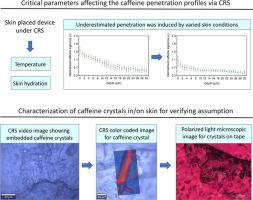International Journal of Pharmaceutics ( IF 5.8 ) Pub Date : 2021-08-28 , DOI: 10.1016/j.ijpharm.2021.121055 Yali Liu 1 , Richard Krombholz 1 , Dominique Jasmin Lunter 1

|
In this research, we addressed a challenge while measuring the penetration performance of caffeine (CAF) using confocal Raman spectroscopy (CRS). Normally in the process of CRS analysis, skin sample was moved from an incubation setup to a specified CRS-measuring sample holder. Accurate data collection may be questioned due to the variation of the environment the skin placed in. Therefore, two critical parameters including the CRS measuring temperature and proper skin hydration were focused; accordingly, four different conditions were designed. First, the skin was incubated in a real-time device with the skin placing onto PBS-filled chamber where the temperature was adjusted to 32℃. This device can be fixed under the CRS microscope, enabling simultaneous skin incubation and dynamic CRS measurements (condition i, reference). The other conditions referred to skins incubated in Franz diffusion cells for simulating the common experimental procedures. In order to control variables of CRS measuring condition, skins were transferred from cells to real-time device and open device. In real-time device, proper skin hydration was maintained and the skin temperature was adjusted to 32℃ (condition ii) and room temperature (condition iii). In open device, the skin was in a less hydrated state by moving onto a PBS-soaked filter paper and wrapped with aluminum foil at room temperature (condition iv). The skin penetration performances measured in these conditions were compared with reference. Caffeine solution and gel formulation were separately applied to the skin. The results showed in both cases that the decrease of skin temperature and hydration in condition iii and iv would apparently induce the decrease of detected caffeine signal, resulting in the inaccurate data collection. To this point, it indicates the reduction of solubilized caffeine in skin layer. We suggest the forming of caffeine crystallization at varied skin conditions to be the factor. Achieved video image, CRS spectrum collection and surface scan demonstrated the caffeine crystallization process on superficial skin layer. Polarized microscopic images exemplified the crystalline drug on tape stripped skin layers. It can be a potential support of caffeine crystallization inside skin. In short, we suggest the consideration of these parameters during CRS measurements for accurate monitoring of topical drug delivery. Meanwhile, the use of real-time device for dynamic skin incubation and data collection provides advantages in saving time and efforts in this study.
中文翻译:

使用共聚焦拉曼光谱准确监测咖啡因在猪皮肤中渗透的关键参数
在这项研究中,我们在使用共焦拉曼光谱 (CRS) 测量咖啡因 (CAF) 的渗透性能时解决了一个挑战。通常在 CRS 分析过程中,皮肤样品从孵化装置转移到指定的 CRS 测量样品架。由于皮肤所处环境的变化,数据收集的准确性可能会受到质疑。因此,CRS 测量温度和适当的皮肤水合作用两个关键参数被重点关注;因此,设计了四种不同的条件。首先,将皮肤在实时装置中温育,将皮肤置于装有 PBS 的腔室中,温度调至 32℃。该设备可以固定在 CRS 显微镜下,可以同时进行皮肤孵化和动态 CRS 测量(条件 i,参考)。其他条件是指在 Franz 扩散池中培养的皮肤,用于模拟常见的实验程序。为了控制CRS测量条件的变量,皮肤从细胞转移到实时装置和开放装置。在实时设备中,保持适当的皮肤水合作用,并将皮肤温度调整为 32℃(条件 ii)和室温(条件 iii)。在开放式装置中,通过移到浸透 PBS 的滤纸上并在室温下用铝箔包裹,皮肤处于水分较少的状态(条件 iv)。在这些条件下测量的皮肤渗透性能与参考进行比较。咖啡因溶液和凝胶制剂分别应用于皮肤。结果表明,在这两种情况下,条件 iii 和 iv 中皮肤温度和水合作用的降低显然会导致检测到的咖啡因信号降低,从而导致数据收集不准确。至此,它表明皮肤层中溶解的咖啡因减少。我们建议在不同的皮肤条件下形成咖啡因结晶是一个因素。获得的视频图像、CRS 光谱采集和表面扫描展示了咖啡因在表层皮肤层的结晶过程。偏振显微图像举例说明了胶带剥离的皮肤层上的结晶药物。它可能是咖啡因在皮肤内结晶的潜在支持。简而言之,我们建议在 CRS 测量期间考虑这些参数,以准确监测局部给药。同时,


























 京公网安备 11010802027423号
京公网安备 11010802027423号